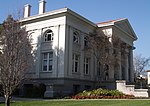1990 Upland earthquake
1990 earthquakes1990 in California1990 natural disasters in the United StatesEarthquakes in CaliforniaUpland, California
The 1990 Upland earthquake occurred at 15:43:37 local time on February 28 with a moment magnitude of 5.7 and a maximum Mercalli Intensity of VII (Very strong). This left-lateral strike-slip earthquake occurred west of the San Andreas Fault System and injured thirty people, with total losses of $12.7 million. Many strong motion instruments captured the event, with an unexpectedly high value seen on water tank near the epicentral area.
Excerpt from the Wikipedia article 1990 Upland earthquake (License: CC BY-SA 3.0, Authors).1990 Upland earthquake
Marshall Canyon Trail,
Geographical coordinates (GPS) Address Nearby Places Show on map
Geographical coordinates (GPS)
| Latitude | Longitude |
|---|---|
| N 34.16 ° | E -117.73 ° |
Address
Marshall Canyon Trail
Marshall Canyon Trail
91711
California, United States
Open on Google Maps







